Robert Dodd stands as a significant figure in the annals of British art, particularly renowned for his mastery of marine painting and printmaking during a pivotal era of Britain's maritime history. Active during the late eighteenth and early nineteenth centuries, Dodd's work provides a vivid and often dramatic window into the naval conflicts and seafaring life that defined Great Britain's global power. His meticulous attention to detail, combined with a flair for capturing the atmosphere of the sea, made him one of the most sought-after artists for depicting the nation's triumphs and tribulations upon the waves.
Early Life and Artistic Beginnings
Born in London in 1748, Robert Dodd entered a world where Britain's maritime influence was steadily growing. Little is definitively known about his early training, though it is generally believed he initially pursued landscape and topographical art. This grounding in careful observation and representation of place likely served him well when he transitioned towards his true calling: the sea. By the early 1770s, Dodd had begun to specialize in marine subjects, a field that offered ample opportunity for patronage and public recognition in an island nation intensely proud of its naval prowess.
His decision to focus on marine art coincided with a period of significant global conflict, including the American War of Independence. This provided Dodd with immediate and compelling subject matter. The demand for images depicting naval engagements, ship portraits, and coastal scenes was high, both from naval officers commissioning portraits of their vessels or victories, and from a public eager for visual representations of current events. Dodd quickly established a reputation for accuracy and artistry.
Rise to Prominence and Exhibitions
Dodd's growing skill and relevance were reflected in his participation in London's vibrant art scene. Around 1780, he began exhibiting his works at the Incorporated Society of Artists, a significant venue for contemporary artists. His presence grew further when, from 1782, he started showing his paintings at the prestigious Royal Academy of Arts in London. He continued to exhibit there regularly until 1809, showcasing a range of marine subjects that cemented his reputation.
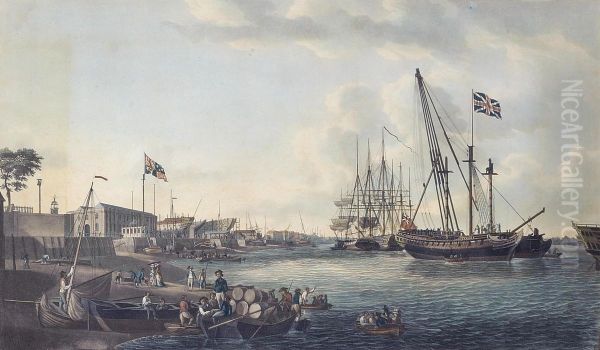
Exhibiting at the Royal Academy was crucial for an artist's career trajectory in this period. It provided exposure to potential patrons, critics, and the wider public. Dodd's consistent presence there indicates the esteem in which his work was held. His paintings often depicted specific, recent naval actions, serving almost as visual journalism for an audience hungry for news of the ongoing wars, particularly against Revolutionary and Napoleonic France. His ability to translate the complex and chaotic reality of sea battles into coherent and dramatic compositions was a key element of his success.
Artistic Style and Technique
Robert Dodd's style is characterized by a commitment to accuracy, particularly in the rendering of ships. He possessed a deep understanding of naval architecture, rigging, and the behaviour of vessels in various sea conditions. This technical precision lent his work an air of authenticity that was highly valued by naval personnel and knowledgeable civilians alike. His ships are not mere generic representations; they are often identifiable vessels, depicted with careful attention to their specific features and flags.
Beyond mere accuracy, Dodd excelled at capturing the atmosphere and drama of the maritime world. He skillfully depicted the changing moods of the sea and sky, from calm harbours to raging storms. His battle scenes are particularly noteworthy for their dynamism and sense of immediacy. He conveyed the chaos of cannon fire, splintering wood, and billowing smoke, while still maintaining a clarity that allowed viewers to understand the unfolding action. While perhaps less overtly romantic or sublime than the later marine works of J.M.W. Turner, Dodd's paintings possess a powerful narrative drive and a tangible sense of realism.
Dodd was proficient in oil painting, the medium for his major exhibition pieces. However, he was also a highly accomplished printmaker, particularly skilled in the technique of aquatint. This process allowed for the creation of tonal areas, mimicking the effects of watercolour washes, and was perfectly suited to reproducing the subtle gradations of sea and sky. His mastery of aquatint was crucial to the dissemination and popularity of his work.
Major Themes and Subjects
The core of Robert Dodd's oeuvre revolves around naval warfare. He chronicled numerous key engagements from the major conflicts of his time. The American War of Independence (1775-1783) provided early subjects, with depictions of actions involving British and American or French vessels. His focus intensified during the French Revolutionary Wars (1792-1802) and the Napoleonic Wars (1803-1815), a period of almost continuous conflict that saw the Royal Navy reach the zenith of its power.
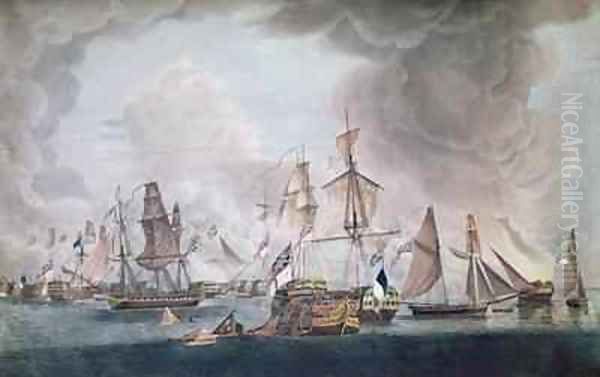
Dodd painted scenes from major fleet actions, such as the Glorious First of June (1794), the Battle of Camperdown (1797), the Battle of the Nile (1798), and arguably his most famous subject, the Battle of Trafalgar (1805). He also depicted numerous single-ship actions, frigate duels, and cutting-out expeditions, celebrating individual acts of bravery and skill. These works served not only as historical records but also as powerful pieces of national propaganda, reinforcing Britain's image as ruler of the waves.
Beyond battle scenes, Dodd also painted ship portraits, detailed renderings of specific naval or merchant vessels, often commissioned by their captains or owners. He produced views of dockyards, such as his notable A View of the Royal Dockyard at Deptford (1789), showcasing the industry and infrastructure behind naval power. Coastal scenes and depictions of ships navigating challenging weather also feature in his work, demonstrating his broader skills as a marine painter. A less typical, but documented, aspect of his career involved providing illustrations for publications like The New Newgate Calendar, which chronicled criminal cases.
Key Works Explored
Among Dodd's most celebrated works are his depictions of the Battle of Trafalgar. He produced several views of this epochal engagement, fought on October 21, 1805, where Admiral Lord Nelson secured a decisive victory over the combined French and Spanish fleets but lost his own life. Dodd's 1806 paintings and subsequent prints of Trafalgar capture the scale and ferocity of the battle, often focusing on the flagship HMS Victory in the thick of the fighting. These images, based on available reports and possibly eyewitness accounts, became iconic representations of the battle for the British public. They showcase his ability to organize a complex, multi-ship engagement into a compelling visual narrative, complete with dramatic weather effects adding to the scene's intensity.
Another significant work is A View of the Royal Dockyard at Deptford (1789). This painting offers a fascinating glimpse into the workings of a major naval shipbuilding and repair facility on the River Thames. Dodd meticulously details the ships under construction or repair, the surrounding buildings, the bustling activity of workers, and the various small craft on the river. It demonstrates his skill in topographical accuracy combined with marine expertise, creating a valuable historical document of naval logistics and industry during the period.
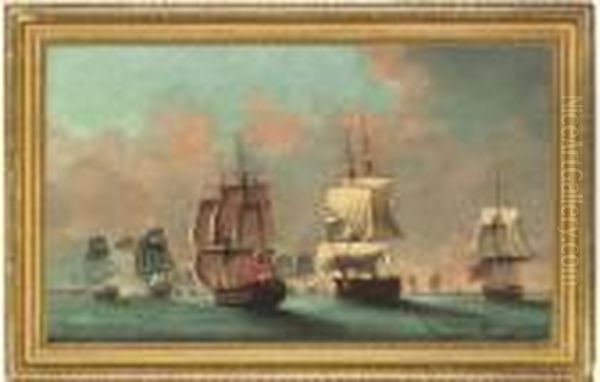
Dodd also produced notable images of the Glorious First of June (1794), the first major fleet action of the French Revolutionary Wars. His paintings and prints depict key moments, such as the breaking of the French line by Admiral Howe's fleet. Similarly, his representations of the Battle of the Nile (1798), Nelson's daring attack on the French fleet anchored in Aboukir Bay, Egypt, captured the drama of this significant strategic victory. Works depicting actions like the Battle of Camperdown (1797), a hard-fought victory against the Dutch fleet, further highlight his role as the pre-eminent visual chronicler of the Royal Navy's exploits.
Printmaking and Publishing Ventures
Robert Dodd's significance extends beyond his oil paintings due to his prolific work as a printmaker and publisher. He embraced the aquatint process, often working in collaboration with engravers or, frequently, engraving the plates himself based on his own paintings. Aquatint allowed for a nuanced rendering of tone and atmosphere, making it ideal for marine subjects and enabling prints that closely resembled watercolour drawings.
Crucially, Dodd often acted as his own publisher, issuing prints directly from his premises in London, notably from Charing Cross. This gave him greater artistic and financial control over his output. It allowed him to respond relatively quickly to public demand for images of recent naval victories. Sets of prints depicting the stages of a major battle, like Trafalgar or the Glorious First of June, were particularly popular. These prints reached a much wider audience than his paintings ever could, decorating homes, taverns, and public buildings across Britain and its colonies.
His prints were not only commercially successful but also served an important function in disseminating information and shaping public perception of naval events. They provided visual evidence, however dramatized, of the bravery of British sailors and the power of the Royal Navy. Dodd also occasionally engraved and published works by other artists, further establishing his role within the London print trade. His entrepreneurial spirit combined with his artistic talent made him a central figure in the visual culture of maritime Britain.
The Golden Age of British Marine Painting
Robert Dodd worked during what is often considered a golden age for British marine painting. The late eighteenth and early nineteenth centuries saw an unprecedented flourishing of the genre, driven by Britain's expanding empire, its reliance on maritime trade, and its almost constant state of naval warfare. National pride was deeply intertwined with the success of the Royal Navy, creating a fertile market for artists who could depict its ships and battles effectively.
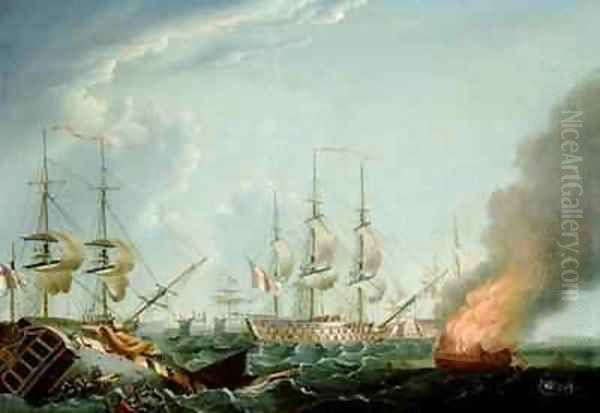
Dodd was a leading figure within this context, but he was not alone. He followed in the tradition of earlier marine painters like Charles Brooking (c.1723-1759), known for his delicate and atmospheric seascapes. A key contemporary and, in some ways, a rival was Dominic Serres the Elder (1719-1793), who held the official position of Marine Painter to King George III and was a founding member of the Royal Academy. Serres' work often had a slightly more formal, panoramic quality compared to Dodd's sometimes more visceral battle scenes.
Other notable marine artists active during Dodd's career included Nicholas Pocock (1740-1821), a former sea captain whose practical experience informed his detailed and accurate depictions of naval actions; Thomas Luny (1759-1837), known for his prolific output and luminous coastal scenes; Francis Swaine (c.1725-1782); and Thomas Whitcombe (c.1763-1824), another prolific painter of naval battles and shipping. John Thomas Serres (1759-1825), Dominic's son, also continued the family tradition, though his career was marred by personal difficulties. William Anderson (1757-1837) specialized in calmer river and coastal scenes, often featuring Dutch influence.
The broader artistic landscape included influential figures like Richard Wilson (1714-1782), a pioneer of British landscape painting, and Paul Sandby (1731-1809), who was instrumental in popularizing aquatint for topographical views, a technique Dodd adapted brilliantly for marine subjects. Later, the towering figure of J.M.W. Turner (1775-1851) would revolutionize marine painting with his highly romantic and expressive interpretations of the sea's power, moving beyond the detailed reportage style often favoured by Dodd and his contemporaries. Philippe Jacques de Loutherbourg (1740-1812), though primarily known for landscapes and stage design, also painted dramatic naval scenes like his own version of the Glorious First of June, known for its theatrical effects.
Later Life and Legacy
Robert Dodd continued to paint and produce prints into the early nineteenth century, documenting the ongoing Napoleonic Wars. His output remained focused on the marine subjects that had defined his career. He lived to witness the final defeat of Napoleon and the dawn of the Pax Britannica, an era largely secured by the naval dominance he had so diligently chronicled.
Robert Dodd passed away in 1815 (some sources suggest 1816, but 1815 is more commonly cited), likely in London. He left behind a substantial body of work, both in oil and print, that serves as an invaluable record of British maritime and naval history during a critical period. His paintings are prized for their accuracy, detail, and dramatic flair, while his prints ensured his vision reached a broad contemporary audience.
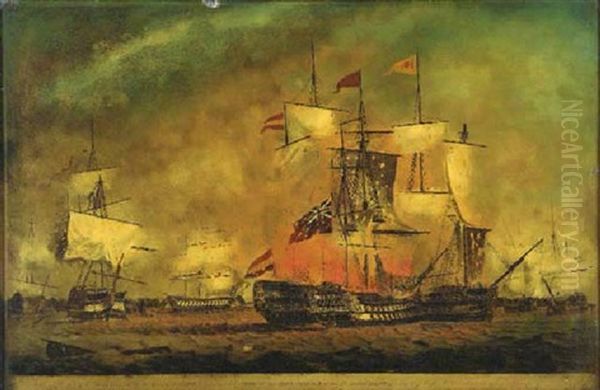
Today, Robert Dodd's works are held in major public collections, most notably the National Maritime Museum in Greenwich, London, which houses a significant number of his paintings and prints. His art is studied not only for its aesthetic merit but also for its historical significance, providing insights into naval tactics, ship design, and the visual culture of late Georgian Britain. He remains recognized as one of the foremost British marine painters of his generation, a dedicated craftsman who expertly captured the essence of Britain's power at sea.
Conclusion: An Enduring Maritime Vision
Robert Dodd's career spanned a period of extraordinary change and conflict, and his art reflects the centrality of the sea to British identity and power during that time. As a painter and printmaker, he combined technical skill with a keen eye for dramatic effect, creating images that both documented and celebrated the achievements of the Royal Navy and the broader maritime world. His dedication to accuracy, particularly in ship portraiture and battle scenes, makes his work a vital resource for historians, while his ability to convey the atmosphere of the ocean ensures its enduring appeal. From the decks of Nelson's flagships to the bustling activity of royal dockyards, Robert Dodd provided a compelling and lasting vision of Britain's age of sail.